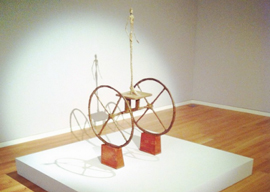
November 15, 2014

Alberto Giacometti, Chariot
Aleko Goulandris is my oldest and closest friend. We met in the summer of 1945, at the Semiramis Hotel in a northern Athenian resort. The Allied bombing and the ensuing communist uprising of 1944 had not been kind to ritzy houses, nor to glitzy hotels. The Semiramis was the only one still operating during the hot months of July and August. Aleko and his twin brother Leonidas befriended me, aged nine, and as they say, it was the start of a beautiful friendship.
The boys were shipping heirs and had become heroes of sorts: during the previous winter, when the battle for Athens was raging, they had answered the call to hold the line against the reds who had come down from the mountains and tried to take over through force of arms. The Goulandris clan is a very large one, and most of them did their duty during the war. My father was down near the Acropolis, where the battle raged for days, and that is where Aleko and Leonidas went and presented themselves. A grizzled veteran told the 16-year-old twins to dig a trench, get inside it, and shoot at anyone who tried to cross after dark.
The twins had a distinctive way of speaking, so when they saw a figure coming, they yelled out “Ti si,” which in Greek military lingo means “who goes there?”
“What are you, Egyptians?”, came the answer of a regular army captain who had been out reconnoitering. The boys took it badly. It got worse the next night when their mother arrived with cakes and other goodies; they endured the barbs of weary veterans who had been fighting on bread and water alone for weeks.
The next time I hooked up with them I was 15 and we were all in Cannes for the summer of 1952. Aleko had a beautiful red sports car, an Allard, and a beautiful American girlfriend. With Nicky lying on the hood, Aleko won first prize for elegance in the most prestigious European automobile show of its time. His twin had a glamorous Hollywood actress, his older brother a beautiful sailing boat, and his sister had bought Eros, a great black schooner that is still sailing the seven seas. I only had a Vespa scooter, but the boys got me into all the nightclubs of the time: Maxim’s, the ones in Juan-les-Pins, and Au Vieux Colombier, where Sidney Bechet played his lungs out every night. It was a magical summer and it was a nightmare having to go back to school. Covered with crabs, as it were.
Last week Aleko became 100 million dollars richer when he sold “Chariot,” a Giacometti bronze of an elongated female, one of the rarest of sculptures. The Sotheby’s salesroom burst into applause, and as I speak to Aleko every day when I’m in Europe—at 10 A.M. exactly—I made sure I got up early and rang him. He had bought the work in 1972 and it was very expensive for the time, he says. “You could buy a 5th Avenue penthouse for much less,” was the way he put it. But unlike the philistine sharks that deal and trade in art nowadays, Aleko has always bought art for art’s sake. He once sat in my house looking for 10 minutes at a Nicolas de Staël of mine, a work he helped me buy in Paris through his connection with the artist’s daughter.